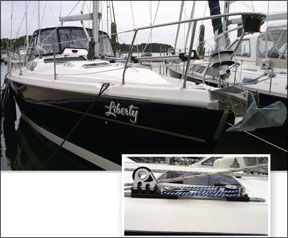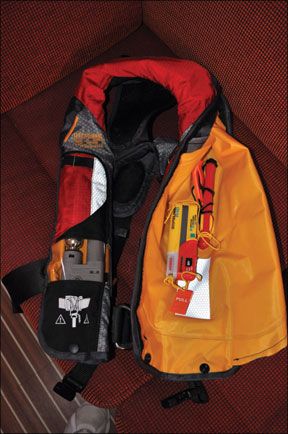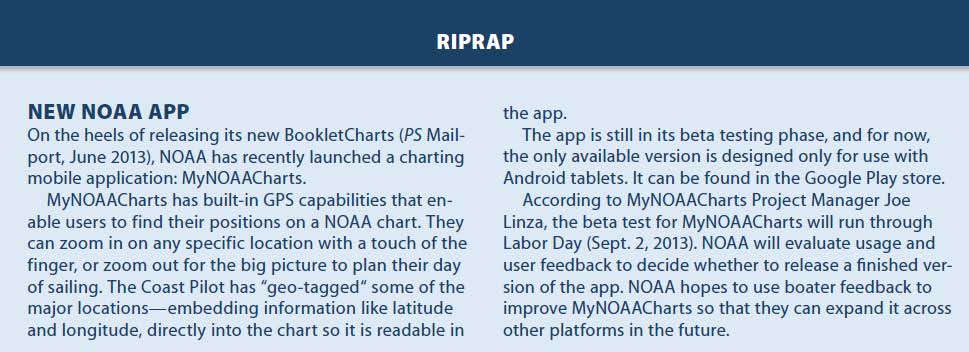A few issues ago, you had a short article on deck hardware (blocks, traveler, cars, etc.) that included Garhauer, and you mentioned that the manufacturer offered individual parts and complete systems that allow conversion from on deck to cockpit adjustment of the car position. We recently installed the EZ adjustable genoa car system from Garhauer and are very pleased with the results. This equipment fits on existing traveler tracks, is easy to install, and performs as advertised.
Photos courtesy of Lenny LipscombPhotos courtesy of Marcus Libkind and Walt WyattPhoto courtesy of Walt Grifel

Lenny Lipscomb,
Liberty, 2001 Hunter 460,
Via email
I also have an inventory of slippery boat shoes caused by hardened soles (PS Advisor, May 2013). I have had very short-term and limited success with sanding the bottoms. Recently, I tried a product on my boat shoes that I use to fix heavy wear areas on my running shoe soles: Shoe Goo, purchased at ACE Hardware. Using a putty knife, I apply a thin layer, and traction is restored, typically for about three months.
Don Doerr,
Orbiter, Backcove 29,
Merritt Island, Fla.
In regard to your May 2013 editorial Buying Into the MOB Fear: Im not sure whether the BoatUS research controlled for it, but I suppose its possible that their findings reflected better training, preparation, and equipment for avoiding and recovery of crew overboard (COB) from larger boats. If a crew member winds up in the drink but is successfully recovered, theyre not going to end up being reported in Morbidity and Mortality Weekly or other sources of outcome statistics.
In short: BoatUS may not have measured COB incidents so much as it assessed COB incidents gone wrong. That is to say, we can fear loss of crew less if were prepared to prevent the splash in the first place, and if the feared should happen, are prepared to recover COB. If fear stimulates preparation and reasoned response, then good on fear!
Douglas Bostrom Via,
www.practical-sailor.com
The Kannad Marine SafeLink R10 (PS, May 2013) is a personal MOB device that when activated, transmits a signal that is displayed on any chartplotter equipped to receive and display an AIS signal.
Photos courtesy of Lenny LipscombPhotos courtesy of Marcus Libkind and Walt WyattPhoto courtesy of Walt Grifel

After reviewing the companys website, including the video showing how easy it is to install in a Type V PFD, I purchased an R10. Boy did I get a surprise when I went to install it. There was no way would it would fit in my Blue Storm PFD. I tried it in a friends Spinlock PFD, and it still would not fit. I visited West Marine, and there was no PFD in stock onto which the R10 could be installed.
I purchased West Marines Offshore Automatic PFD anyway, and with a minor modification to the PFD, I was able to make the R10 fit. (Im refraining from describing the modification because, though I am confident that the integrity of the PFD is not compromised by the change, I don’t think it is right to advocate such a modification.)
So in my case, the real cost of the Kannad SafeLink R10 was the $300 purchase price, plus more than $200 for a new PFD.

Marcus Libkind,
Tradewinds Sailing Club,
Richmond, Calif.
Your experience is a great reminder: Before buying any MOB beacon like those we reviewed in the May 2013 report, contact the manufacturer to be sure it will fit your specific PFD model. The non-floating SafeLink comes with a 3-foot lanyard, a padded case equipped with a clip, and a back loop that can be threaded onto to a life jackets strap. It can also be set up for automatic activation when fitted to certain life jackets, but that setup has to be carried out by the PFD manufacturer or an authorized service center.
According to Kannad parent company, Oriola, they had no problems fitting the R10 inside off-the-shelf inflatable PFDs (including the West Marine Offshore PFD and more than a dozen other American life jackets) during pre-production and sea trials. Some fit right-handed, some left-handed, depending on where the oral tube lay inside the outer casing, Oriolas Bill Eastwood explained.
Based on your review of the Lehr outboard propane motors, I purchased a 5-horsepower, long shaft for my Precision 23. I have not yet tried it out other than in my dealers test tank at setup, but I did find the owners manual unclear, so I phoned the company and got the following info.
Photos courtesy of Lenny LipscombPhotos courtesy of Marcus Libkind and Walt WyattPhoto courtesy of Walt Grifel

If you stop the motor for more than 30 minutes, you must disconnect the 1-pound propane fuel bottle. This will not be fun while the motor is over the water, or even at the dock. They suggested using their remote tank, which has a shut-off valve. One of the reasons for my buying the motor was to get away from hoses and remote tanks. How about a shutoff valve in the motor?
Secondly, I believe the motor should be covered when not in use as the opening for the bottle provides a way for rainwater to get inside the motor case. The manufacturer told me that they were discussing a cover idea.
Walt Wyatt,
SeaDuced,
Precision 23 Cincinnati,
Ohio Brookville Lake, Ind.
I liked the intent of your April 2013 anchor shank article, but I really object to the metric units. What percentage of your readership do you possibly think can relate to newtons, megapascals, etc.? Some day, the U.S. may go metric, but I do not think PS should take the lead on this. Please stop.
Jack Rackliffe
Marina del Rey, Calif.
We apologize for any irritation the use of metric may have caused. The test was conducted in Australia, using metric equipment. The editor, his brain reeling from spring refit projects, made a foolhardy attempt to again test the readerships readiness for a metric conversion. This was, as his 10-year-old son would say, an epic fail. In the future, we will convert when feasible, or offer both metric and U.S. Because the conversion from megapascals to pounds per square inch results in nine-digit numbers for anchor steel (1 megapascal = 145 pounds per square inch), and because megapascal is the most common term used for the strength of anchor steel these days, we intend to stick with megapascals, unless we hear an uproar from more readers who insist on pounds per square inch. In the end, the relative numbers are what matter here.
I came across the Drainman Automatic Bilge Pump in the Jamestown Distributors catalog. It uses the motion of the boat (like tidal energy) to pump out the bilge, claiming 660 gallons per day. It sounds like a simple yet effective solution for boaters like me who are at a mooring and worry about battery drain when were away. Jamestown lists it for $45. Are you aware of this product, or other non-electrical products like it?
Walt Grifel Impromptu,
Sabre 28
Key Biscayne, Fla.
Weve got a Drainman bilge pump on hand and plan to report on it in a future issue. In the little bit of testing weve done on it so far, it did not impress testers. However, the testing was in a fairly protected anchorage that sees little wave action. It may be more effective in mooring fields that see a lot of tidal surge or more boat traffic. Another solution that wont drain your batteries is a solar-powered bilge pump like the EasyBailer and the SeaJoule Marine, which we reviewed in the July 2011 issue. Weve been using those for more than a year, and they seem much more effective than the Drainman-type designs.
In response to your snubber test (PS, June 2013): How does a boat owner determine the load on their anchor gear for sizing chain, snubbers, and anchors? I understand that displacement, windage, wind speed, and sea state all play a significant role, but is there a general guideline?
Richard Lewis Via
www.practical-sailor.com
All ground tackle should be sized for shock loads in storm conditions; shock loads require much more holding power than typical anchoring. In her Voyagers Handbook, PS contributor and bluewater voyager Beth Leonard explains that most cruisers use anchors sized for a boat 10 to 20 feet longer than theirs actually is. A similar rule is applied to anchor rodes. A standard rule of thumb, according to Leonard, is to choose anchor line that is 1/8 inches in diameter for every 9 feet of boat length; chain should be half the line diameter. For more, check out our May 2012 article on anchor testing and rode loads, as well as the ABYC table referenced in this issue.
I would greatly appreciate your thoughts regarding the snatch load a 27-foot sailboat weighing 6,000 pounds with a fin keel is likely to encounter under extreme storm conditions on the Northern Chesapeake Bay (mud bottom). Lets assume these storm conditions are caused by 6-foot waves and continuous but varying wind gusts of 30 to 55 miles per hour hitting the boat as Practical Sailor tested (PS, April and May 2013); well set but not completely buried with a 5:1 scope and snatched at 90 degrees from the set direction.
Photos courtesy of Lenny LipscombPhotos courtesy of Marcus Libkind and Walt WyattPhoto courtesy of Walt Grifel

By any chance, have you developed an algorithm for predicting safe snatch loads to avoid bending the anchors shank?
Do you have a guideline for estimating the load at which an anchor is likely to be pulled out of a good setting? I am familiar with the holding power guidelines my anchors manufacturer provides, but I am interested in your estimates as I have a feeling they will be different.
I have been caught in squalls when the anchor held well for the first half-hour, but after encountering repeated blows from aggressive waves for an extended period of time, the anchor drags. Are you aware of any anchor-holding test conducted over time to assess an anchors holding power?
Richard Paden
Petite Cherie, 1974 Dufour 27 (#193)
Chesapeake Bay, Severna Park, Md.
We delved into the topic of rode loads in the November 2012 issue. We arent aware of any tests that could answer your questions about your anchors holding power over time or under snatch loads. Often, a good anchor will set deeper in the conditions you describe, but because you are in shallow water, you lose most of the advantage of chain catenary in absorbing shock loads. A long nylon snubber with chafe protection, where needed, is essential in your situation. As we stated in our November 2012 report on rode loads, there are many published charts of theoretical loads. Probably the most commonly cited table of anchor loads in the U.S. is the table of theoretical loads used by the American Boat and Yacht Council in its Standards and Technical Information Reports for Small Craft, revised most recently in 2008. Indicating minimum design loads for deck hardware used for anchoring or mooring (cleats, bitts, samson posts, etc.), the table lists calculated loads according to boat size, ranging from 10 to 60 feet. According to that table, permanent mooring hardware on a 35-foot sailboat (allowing a margin of safety in your case) should be able to withstand 2,700-pound working loads.
Assuming this as your baseline, and including a margin for error, an appropriately sized (see previous letter), brand name anchor constructed from declared, high-tensile raw materials, such as ASTM 514, should be reliable.
In the May 2013 issue, the discussion of 316 stainless, in the Of Megapascals and Ultra-Strong Alloys sidebar (on page 16), should have read yield strength not tensile strength.
Olivia Constants, the young 420 sailor who drowned in 2011, was misidentified in the June 2013 editorial.



































